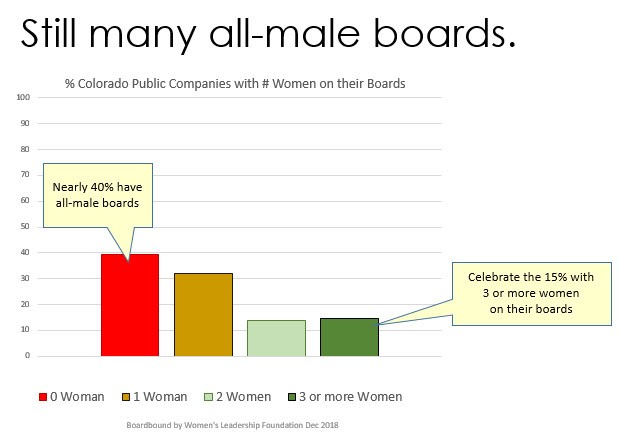Women On Board with Jo Lynne Whiting
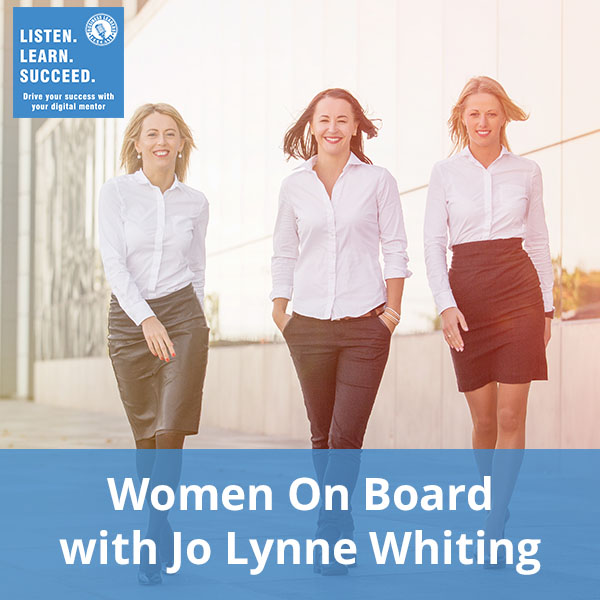

More than having such caring and nurturing hands, women nowadays have also demonstrated their power and strength on the business and corporate side. Jo Lynne Whiting, the Board Chair of the Women’s Leadership Foundation, believes that having more women on board is critical to the success of companies. She talks about how women can become a great leader to spearhead company success and create better economic development.
Women On Board with Jo Lynne Whiting
We’re incredibly fortunate because I have Jo Lynne Whiting. She is the Board Chair of the Women’s Leadership Foundation. I had the pleasure of meeting her at an event where women were talking about being on boards. Jo Lynne, thanks for taking your time. Tell us a little bit about the foundation and what your mission is.
Boardbound by Women’s Leadership Foundation, we are working for advocacy because we believe that having more women on boards is critical to the success of their companies. Fortunately, the research bears that out. We also work on the supply. We have a Boardbound program that equips women to step into board service and we work on-demand. We think there are a lot of very talented women already out there. The more that companies, CEOs, board directors, the chair nominating governance asked for those women and look for them, the better off we’ll be and we’ll have more balance on our boards.
How long has the foundation been around?
We were legally formed in 2002. The Colorado Women’s Chamber of Commerce formed an independent foundation and we were rather dormant until 2011 when we adopted a mission. The way we did that is we did research of what’s already going on here in Colorado, where are women succeeding and where are the gaps. One of the gaps that stood out was breaking that glass ceiling to get on the board. That is what we focused on. We started with research. In the very first research study, we learned that there was only 7% of the board positions in Colorado held by women.
How did that relate to the rest of the country as a comparison?
At that point in time, we didn’t have a good benchmark because you need to adjust to the size of companies. Back in 2011, you’ll hear publications say, “We’ve got 12%. We’ve got 14%.” They might have been only talking about the larger companies and here in Colorado, we do have a lot of smaller companies which tend to have fewer. Now, we know that and we know we’re about 2 percentage points behind the national average. We’re about 9 percentage points behind some of the best states whose companies that are headquartered there have done a great job of getting women on boards.
As far as percentage gains from where you were, you have made great strides.
It’s everyone, both men and women, working together that are going to make this a better world and a better business environment.
We’re excited. It is slow, but it is a steady increase. We started at seven and I’m very proud to say that as of December 31st of 2018, we’re at 14.4%.
How does that put you in comparison to other states?
We’re still behind by about those 2 percentage points. The part that’s encouraging is if you look at 2018, we had a 2.1 percentage point gain and the previous six years it was less than one point. We’re encouraged because a lot of Coloradans have gotten behind this. Colorado was the fourth state to pass a resolution by both houses in support of having women on boards. Even before that, we had been working with some wonderful CEOs who brought their fellow CEOs and board directors together to talk about this issue. They had made a commitment and they were in support and help support that legislative resolution. People like Dave Liniger of RE/MAX, Pattye Moore who’s the Board Chair of Red Robin Gourmet Burgers, and Jerre Stead of IHS Markit were all great supporters.
Gary Goldberg of Newmont Mining. It has five women on their board. A lot of people would say that that’s an area that would not be traditional for women. They have a woman board chair and they have been very successful. Gary is a great leader and very thoughtful about how to make their global operations responsive to women. He talked about the gold mines in Africa and being sure that having women truck drivers for the gold mines in Africa was very unexpected. It has been quite productive once they introduced the concept that this is possible.
I knew a gentleman that had a fairly large construction company and he said that women were better drivers and they didn’t tear up the equipment near as much.
That’s what Newmont found too.
The recognition wave on the Women’s Movement, but you were advocating way before that timeframe. I don’t think a lot of people know the numbers on a dollars and cents basis the effect of having women on the board.
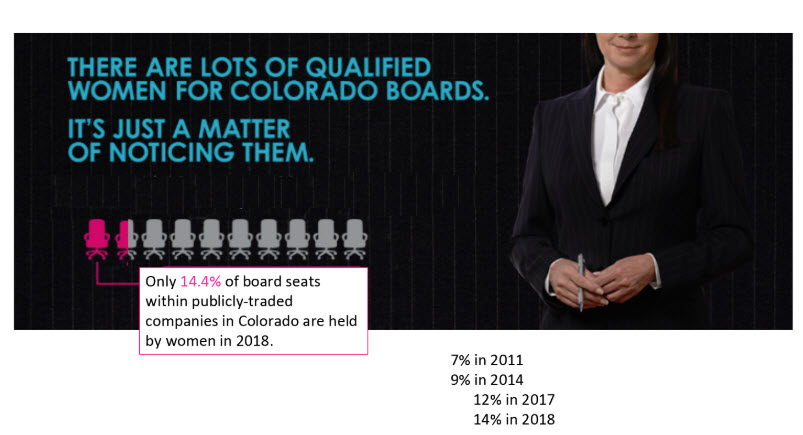
That’s been one of the things that is important. One of the things that has been great is investors have gotten behind this issue. Part of it is there is research that did a study following companies over a five-year period to say those that had three or more women on their board for that five years, how did they perform versus those with all-male boards. The companies that had three or more had a 37% increase in earnings and those with all-male boards had an 8% decline in earnings.
There are two things from that that are important. Three or more is a great number because you get past tokenism. The women that are participating are participating as individuals, not representing a whole gender, but bringing in their own skill set. The other thing is that it’s the diversity. Another research done by the Conference Board said that the performance of the whole board improves. They use the term effort norms. If a new woman gets on board, she often is very excited about this and very diligent about her preparation.
She comes in with good questions, but what happens is the rest of the board members also get more engaged. A lot of the research is not like, “Why is that performance improved?” It’s not simply because of the contribution. The women are the effect of having diverse perspectives of women and men and also different ethnic backgrounds. That’s the other thing where we are looking at. We have looked at the fact that we need more women on boards. If you look at the proportion of the population, we need about twice as many. We need about three times as many African American women on boards and we need eleven times as many Latinas on boards. We started Latinas in the Board room to focus on that. We’re proud that in our Corporate Boardbound program, we have Latinas and African-Americans. We have a good mix of people participating which enriches the program.
I’m thinking about the business owner that’s going, “I’ve got concerns about my board. I’ve got a board member rotating off and I want to take in and add diversity to my board.” What’s the approach? How do they find you and what happens next?
We would love for them to call us. A lot of larger companies have search firms. It’s wonderful if you have a search firm that is committed to bringing forth women candidates too. We were excited that Heidrick & Struggles has adopted a policy that half of their slate over a year to all of their clients will be women and racial candidates. That’s good, but that has not been the trend. That’s a new positive development. A lot of search firms tend to bring forth the people that are already on boards, which are predominantly white men. One of the things that we offer in any company that is interested in our Boardconnect program is that we’d love to listen to your requirements and what you need. What are those strategic skills that will help your business get ahead?
It’s good for kids to know that whether they were born a boy or a girl, they’re going to do great things in life.
We will bring you some women candidates and introduce you to some women candidates that we think would be good for you to consider. We’re able to look at that within Colorado because we know that 70 or so women living in Colorado are already on corporate boards. We’re able to look at our women that have already gone through our Boardbound program. They are C-Suite level. They have great expertise and they are prepared for board service. We also have a national network that we can tap so we can get candidates across the nation for a company’s consideration. We’re not a search firm and we don’t do due diligence on all of the candidates, but we are a valuable resource. We’re bringing you candidates that meet your needs that you then can decide if you think they’re a good match for your company’s board.
We were talking about the inventory of women and we were talking about in your career when you were working for a telecom in the corporate world. You didn’t even know that and I didn’t even know about that progression in your career. You built a company and sold a company, so you have the business ownership side. For some of the women they are going, “I’m looking for an expanded leadership role.” What types of things does Boardbound cover for them?
This is very important. We would love any college student that is thinking about their career, to begin having in their mind not only what’s my career path, but how does that include board service? Because it does take preparation. Many women who have large teams, they manage profit and loss. They may be cyber experts, they may be good in innovation and product development and growing the top line. All these skills that are proven are great qualifications. The first thing to do is to recognize that board service is something that you may want as part of your career. To prepare that, the basic foundation is to be good in your own job and to have a great track record because that gives reassurance to people. If you’re on a board, you’re representing a lot of the shareholders. You are looking for the future health of that company. You may not be a CPA, but you have to understand financial basics. You understand what the drivers are, the top line and the bottom line and how to bring that together.
We have two programs that might be helpful. The first one we call Community Boardbound. For women younger in their career or women that now have the breathing space to give back. It is a program to prepare you to serve on nonprofit boards, on hospitals, on university boards, on city and state boards and commissions. A lot of these are very important and very influential. It can make a big difference to our society. That program is a six-workshop certificate program and at the last workshop, there’s a little bit of speed dating between you and other organizations that are looking for boards. Even if it’s not a perfect match, you at least are thinking, “Do I want to be on a board that is education-focused, health-focused or different areas?”
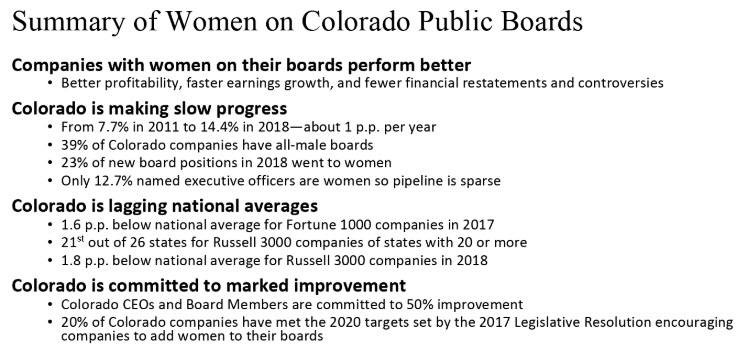
Our second program is Corporate Boardbound. That’s a year-long program. It is fee-based. You have workshops and you also are assigned a mentor. Your mentor is someone that is a director of a corporate board so they can share their story and demystify what this means to have board service. That has been very helpful. You’ll get a one-on-one on governance and what the responsibilities are and what companies say they’re looking for in board members. You then prepare your board bio and résumé and then you think about, “What’s my unique value proposition? Will I be good for compensation committee or the audit committee? What would make someone want me for their board? What’s my target list of companies that I think I could add value to. How do I have a networking plan?”
This isn’t direct. People don’t advertise and say, “We’re looking for a board director.” It’s more networking. Most of the people that go through our Corporate Boardbound program, we’re very proud. We have had twelve go through in 2018 and we’ve had six that are on boards now. We think that a lot of the others have great prospects. A lot of them will find that board position through their own network, but because they’ve gone through Boardbound, they’ve got a clearer idea of how people can help them. They can articulate what their goals are and what their values would be in their network and it can help them find what seems like a reasonable match.
If they have not been on a board before and they serve on a board, what’s the transformation that happens to that woman that then has board experience? What do you see the change if there is one?
The biggest challenge is strategic thinking. If you’re in an executive position and you’re responsible for a department or if you are a person that’s grown your own business and is a successful CEO of your own business, you are very operationally-oriented. You think strategically about where you want to go, but your life is mainly executing what you need to do to be successful. If you’re on a board, your role shifts. You’re not the person that’s doing it, you’re the person that’s asking the right questions to be sure the right information is coming forward and that the strategy is clear. The accountability is clear and that the right people are in place. That transition from executive to the broader governance helps you to be more strategic for the rest of your life. You’re going to meet very interesting people. You’re going to meet thoughtful, successful, conscientious and caring people. They’re going to have perspectives based upon their life experiences which may be very different from your own. If you look for leadership development, serving on a board is greater than most university programs that you could do.
If you have a goal, put your energy towards it and just work hard.
A lot of times I’ll talk to people and they go, “They don’t know what they don’t know.” They don’t even know they should know. I think about for women that may want to take and serve on a board and they go, “I don’t even know where to get started. I haven’t framed the question. Why would somebody want me on the board? I just do this or whatever.” Let’s say that you’re a young woman starting your career and you go, “My five to ten-year goal is to serve on a corporate board, but I’m here.” Would the progression be getting on a smaller municipal nonprofit board?
That would be very valuable. You’d learn board process and governance responsibilities so that is very valuable. In Colorado, one of the things that I’m excited about is we’ve got a great cooperative relationship with other organizations concerned about this. We’re Boardbound by Women’s Leadership Foundation. We focus 100% on this. Colorado has the National Association of Corporate Directors Chapter. One thing you could do is attend one of their meetings, NACD. In that meeting will be a lot of current directors addressing issues that are important to the directors. You’ll get a lot of exposure and understanding and a feeling of, “Is this something that I want to seriously proceed with?” There is also a newly formed chapter of Women Corporate Directors. Many of them have been very helpful to us because we have women and men who are mentors in our Corporate Boardbound program. We are deeply appreciative of them sharing their time to work one-on-one with someone to help them along this path, because as you say, you may not know people in your life that are on boards.
Almost any publication that talks about how you succeed, there’s always a mentor somewhere or it seems like and you go, “How do I find a qualified one?” In this type of arrangement, there will be mentors like you were talking about in the training program. You were assigned a mentor and they go, “What a gift.” That is a gift.
They meet each other. They make sure they’re both comfortable proceeding with this year-long commitment. Some of our mentors have stayed involved past the year. It takes a lot of persistence and you have to think about and work at this. We just heard the story of a man that got on two boards within one year and a friend told him how lucky he was. He said, “I’m not lucky. I sat down at [8:30] every morning and worked on this.”
You have some marketing background and you’re marketing the product you know best. It’s a concerted goal and effort to get it done.
For the CEOs, I would encourage them to talk to us. There’s no risk to say, “Share with me some potential candidates.” I’ve sat down with some of them and gone over the qualifications. I’m remembering this one man. His eyes got bigger and he said, “They are so good.” In another case, someone said, “They might intimidate our current board.” We don’t want people to be fearful, but it was a sign that it was a powerful résumé. There are a lot of good and talented women that have accomplished a lot of wonderful things that could help businesses be successful. That’s what’s exciting for us. When you get that magic working for the woman and the company and they’re both excited that they’re going to have a stronger board and that they’re going to be more successful.

Do you have some events periodically through the year?
We have one coming up with the Colorado Women’s Bar Association. The one that you attended this fall was with the Women in Mergers and Acquisitions Network. We have some of our own events like Community Boardbound workshops and that thing. We also would invite other professional groups to partner with us or invite us to be a speaker or to partner with us in developing a program that meets the needs of their members. I thought that was a great one. We had 100 women and men that were professionals in mergers and acquisitions. We had a great speaker that had talked about implicit bias. We had on that panel Ginger Graham with Walgreens board, John Kelley who is a wonderful CEO of CereScan and also has been a mentor in our Corporate Boardbound program and many other bright people that come together. We have our programs and we’re also excited to work with other organizations that are interested in this subject to develop something that works for them.
The whole topic is, “You don’t know what you don’t know.” I’m not altogether sure how well it’s known in the business community about, “What’s in it for me?” or “Your bottom line does better,” and you go, “That’s what’s in it for you.” I think about the challenges to get the word out. If somebody wants to find you and the organization on social media, how do they find you?
We are at WomensLeadershipFoundation.org.
I was on the site and there’s a wealth of information. There are a lot of case examples of very successful women that are serving on boards and there’s a description of your training programs as well. If folks are interested and are piqued about this, that’s a very good first place to start.
Even if someone isn’t interested themselves on being on a board, that could help the cause. They can be sure that the companies that they do business with, they can find out, “Do they have women on their boards?” Just one question to an executive is, “Have you thought about having women on your boards?” This is one of the problems in Colorado. We’ve said that we’re a little bit behind and that’s mainly because 40% of our public companies still have all male boards. That’s much higher than the national average and I don’t think it’s even in their own best interest to do that. We’d love to partner with them. If they’re not interested in personally being on a board, they can still make a big difference at the companies they shop with and the companies they invest in. If they are conscious of, “Are there women on the boards?” It’s all of us working together that are going to make this a better world, a better business environment and a better society. We’re appreciative for your help to get the word out.
Realize who can make the difference; it’s the CEOs and board chairs.
I think just in demographics, it’s roughly half men and half women and you go, “If your board is all one or the other, you’re missing out on half of the perspective.” Common sense dictates you should have some level of parity on board. I was thinking about your example on the Newmont board that has a fair quantity of women on the board.
They have five women and a woman board chair and a wonderful CEO, Gary Goldberg.
We’re going to shift gears a little bit. Looking back, maybe it would be good to talk about a little bit of your background. What you do and some of the challenges that you ran across in your career that have helped you going forward?
I grew up in Texas on a ranch my family has settled many years ago. Most of the women were teachers and most of the men were ranchers. You talked about not knowing what you don’t know about. I did not think of a business career. After I graduated from college and had done a little bit of student teaching at that time, I thought, “I’m not so sure about that.” I was very interested in this book, Education and Ecstasy by George B. Leonard. When computers were coming out and people were saying, “If you teach at the point of curiosity, the learning will be so much more exciting.” I heard that in Colorado they had this PhD program for educational research at the University of Colorado. I applied, I was accepted, but I needed to live here a year to get residency. I started working at the telephone company. It was Mountain Bell at that time.
I started as a service representative. I found that I liked the business world better than I thought I would. Earlier I thought, “You were either a capitalist pig or a nerd to join the business.” It was very interesting having direct interface with customers, so I decided to switch to an MBA. I decided to commit myself to a business career. I loved my career within the company. I was working with US West. I left in 2000. When it was acquired by Qwest, we had 27% women on our board. It was twice the S&P 500 average. This was back in 2000 and we also had twice as many women executive officers. We had the best shareholder value appreciation of any of the seven regional Bell operating companies formed at the time of AT&T divestiture. That was something we had always worked on was pairing that diversity with success.
I take it that it’s completely different than the other Regional Bells?
All of the Bell companies were better than average, but we were the best on these issues. I started my career way back in 1971. I was going to work until I qualified to go to my graduate program. I was offered a promotion after one year and I decided, “I’ll go ahead and take this promotion and I will switch and get an MBA going to night school.” In 1973, the AT&T-EEOC Consent Decree happened. It was the largest EEOC Consent Decree in the nation. What had happened is a lot of companies had discriminated but AT&T documented it. The Consent Decree required that you would have at least 25% of women in middle management within five years. It was fascinating for me. You talk about seeing these people that I went to break with talk about their families and their community and what they were doing in their personal life and then the Consent Decree happened.
You had people, “I’m going to go back to graduate school. I’m going to pursue this.” The break talk was about business and the break talk was about, “If the husband doesn’t like this, he better get with the program because I need to go after this.” You saw the energy. I remember someone did behavioral studies at the time and he said, “You don’t aspire what you cannot hope for.” I saw that when there was hope, people’s energy moves dramatically. We were successful in meeting that benchmark. All of the Bell companies then have that level of success, but what happened in our company is that we noticed that it began to plateau after that. We tried to form a win-win relationship between the women, the company and the executives. We formed US West Women. We worked with the CEOs. We had gatherings with officers. We presented the data. We applauded the success stories when women went into the network organization and that thing.
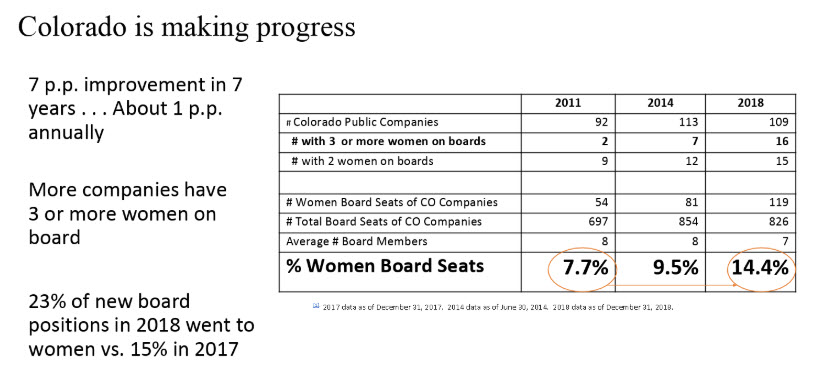
That is part of my inspiration for wanting to be involved with Boardbound by Women’s Leadership Foundation. I’m thinking that I saw that within a microcosm of one company and why can’t we do that in Colorado? We’re on that track. There are a lot of wonderful CEOs that are embracing that. That’s what made a difference for our company. We have three CEOs that believed that this was a good thing to do. There are a lot of CEOs here in Colorado that are committed. Kent Thiry of DaVita committed to the majority diverse board and has accomplished it. We’ve got an honor roll of companies, but we have others that haven’t thought about it. A lot of the companies don’t have women on their boards yet, they just haven’t thought about it.
You think about what’s the tipping point for that thought process. If you have 100% one-type of board, this is your profitability. If you have this type of board, there’s a good chance that your profitability will go up by a third and you go buy a new equipment or maybe not. You go, “Why would you do that?” I don’t know that it’s that simple. At some point, you then left Corporate America and you struck out to be an entrepreneur.
I did take a sabbatical a couple of years. I was working as many as 60-hour weeks and my life was programmed for weeks ahead. I felt that I needed to switch gears. I remember going to the athletic club and seeing all these other people younger than me exercising in the middle of the day and I go, “I never would have thought that.” I did get involved in consulting. I consulted in Europe, Australia, Singapore and here in the US. It was fun and I liked it in marketing and strategy. In 2005, I invested in the home health business. It was in Texas and we’ve started it and we grew it. I became the Chair of our board. I had been involved at nonprofit boards, but that was my first a for-profit board. As I became Chair, I helped oversee the negotiation to sell the entity after the five-year mark when we felt that we either needed to take it to the next level or we need to sell it to someone who was wanting to do that. That was a wonderful experience.
I think about the mission statement and the things that you are trying to do. If you could put an ad on the front page of the local business journal, what would it say and why?
Colorado can be a leader with women on boards. We, together, can transform this from being a bit of a laggard to being a leader. When we do that, we’re going to be more successful and our companies are going to be more successful. We’ll have better economic development for the state, and we’ll have a lot of talented people being able to tap their resources and what they’re able to give. Won’t it be good for all of our kids that they know, whether you’re born a boy or a girl, you’re going to do great things in life?
When you look back over all your experiences when you allocated your time, what do you think the best return on the allocation of time that you had? What did you do that did the best for you?
I could learn from other people on this. What I did is pour lots of hours in what I care about. It’s that waking up early thinking about it. It’s that working, persisting and being inspired to work a little more on it. I don’t know if my allocation is the greatest. If you have a goal and you put your energy towards it, what I’ve done is just work hard.
It’s a focus effect. If you’re scattered, it’s hard if you work. If I was to talk to some of the folks and say, “You have an unusual habit that’s helped you succeed,” what would that be? I saw you come in with your Franklin day planner.
I do carry this. I have tried the electronic. I used my smartphone, but I like this and I’m still committed to it. I can find meetings quicker than my friends that are using their smartphones.
Over the past few years in the organization, is there a belief or a protocol that you have established that helped this progression of Women on Boards in Colorado?
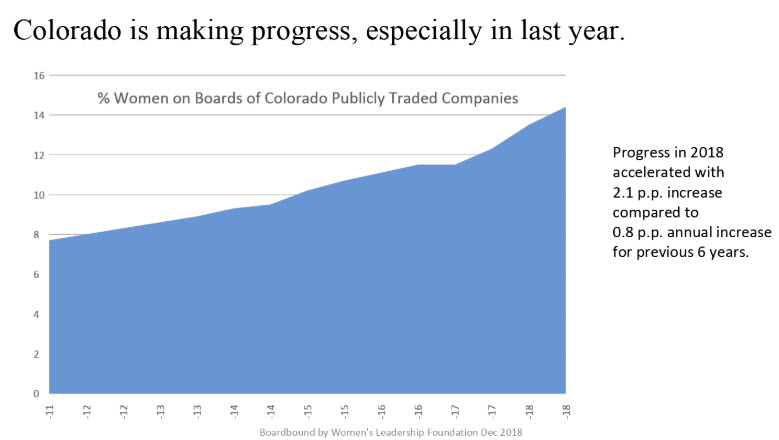
Gloria Zamora is the Vice Chair of Boardbound by Women’s Leadership Foundation. We had a meeting with a very wise person to ask who was on the board and ask him how he thought we could make the most difference. He said, “Realize who can make the difference.” It is the CEOs and it’s one CEO speaking to their fellow CEOs who are going to make the most difference. That’s why we felt good about the six or so meetings we’ve had over the last couple of years. We’ve had 30 to 50 CEOs and board directors that have gotten together to talk about this and talk about what actions they could take, and we can support that would help us progress.
The answer was realizing our organization is here to help bring a focus to catalyze energy, but we’re not the people that are going to make this difference. It is the CEOs and the board chairs, and chairs of nominating governance committee who will decide whether this is a good thing for their company or not. Direct engagement with them and acknowledging that they are the ones and we’re here to support them. That has made a big difference. It’s a principle. It’s a belief that we have. We want those companies to be successful. They realized that we are motivated for their success. That’s made a big difference.
You talked about the statistics. As more women serve on more boards, then the statistics become more compelling. Being somewhat of a stats guy myself, you think about that and go, “Don’t be stupid.”
Besides better return, there are 40% fewer financial reinstatements if you have women on board and there are fewer governance controversies. It helps achieve the upside and avoid the downside to have women be part of the boards.
I think about risk management and it’s back to that, “I don’t think they know what they don’t,” and maybe that’s it. For a first time CEO, what advice would you offer?
It’s always the team. We’re very lucky on our board of Women’s Leadership Foundation. I’m in admiration for the people on our board. They’re very committed. They’re pouring their own time and energy into this. They’re very talented. As a CEO, the highest payoff is to have the right people with you and to make good decisions on who you recruit to be on the team.
For misconceptions about the Women’s Leadership Foundation, what would you say is the biggest misconception?
Our name is generic and that’s one reason we’ve adopted Boardbound by Women’s Leadership Foundation so that people know it’s board-bound. A lot of people, when you say Women’s Leadership Foundation, they’re like, “Is it the Women’s Foundation of Colorado?” There are several groups. Our new logo is Boardbound by Women’s Leadership Foundation and we’ve done that to try to clear up the misconception.
Looking back over the past few years, we can always figure out what we should have said yes to. What should you have said no to and why?
Maybe some consulting assignments that I’ve done. I wanted to help a friend, but the company wasn’t ready to move, and it wasn’t ready to take the advice. We did a lot of good work. We still believe it could have been quite productive, but it’s disheartening when you see that it wasn’t implemented. Maybe being a little more judicious about which assignments have a higher probability of success.
For me, I raise both my kids. I have a boy and a girl and I raise them the same way. They both do all the stuff together. I’m a firm believer or I wouldn’t be here. I must admit I was highly outnumbered at the women’s event. That was a lot of fun. I appreciate you taking the time. I look forward to much success for you.
Thank you, Bob. I appreciate it.
Links Mentioned:
- Women’s Leadership Foundation
- Boardbound
- Newmont Mining
- Heidrick & Struggles
- Community Boardbound
- Corporate Boardbound
- NACD
- Education and Ecstasy
- CereScan
- https://WomensLeadershipFoundation.org/
About Jo Lynne Whiting
Jo Lynne has expertise in strategy, marketing, sales and operations. She combines analytical insight with pragmatic action to grow usage, revenue and profits. Focusing in telecommunications and advertising, she has grown share for companies she works with time and again.
She has consulted in the United States, Europe, Singapore and Australia with a range of work from new product development to field operations, aligning cross-functional workforce around customer needs to achieve industry leading results.
Before consulting, she was part of executive teams at Sensis and Dex who led the world in industry revenue growth, usage and profitability. She was responsible for marketing, online product development and National sales.
She was an officer of US WEST (now Century Link) as VP–Local Markets for broadband and mobile networks as well as VP-Strategy for Local Search Advertising.
Her Board experience includes being Board Chair of a private venture (Texoma Home Health) where she helped found the startup, establish 5 year track record and then successfully negotiated the sale of the company. Her civic leadership focuses on environmental and women’s issues.
Love the show? Subscribe, rate, review, and share!
Join the Business Leaders Podcast Community today:
- businessleaderspodcast.com
- Business Leaders Facebook
- Business Leaders Twitter
- Business Leader LinkedIn
- Business Leaders YouTube
The post Women On Board with Jo Lynne Whiting appeared first on My podcast website.

